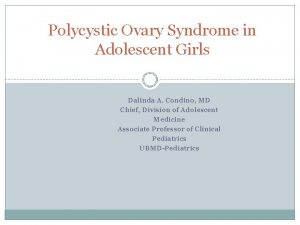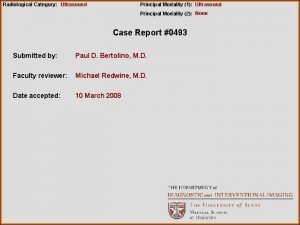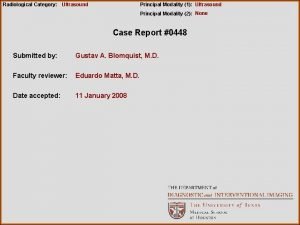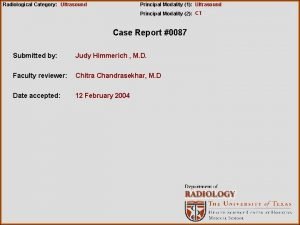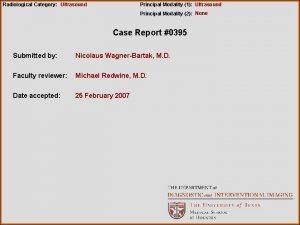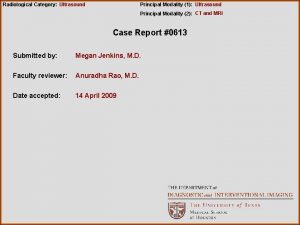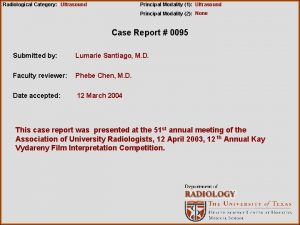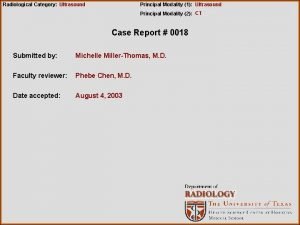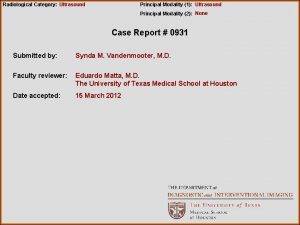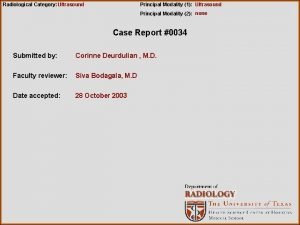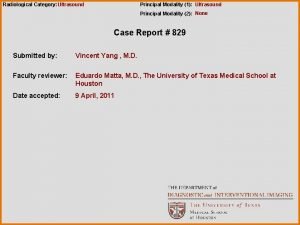Radiological Category Ultrasound Principal Modality 1 Ultrasound Principal













- Slides: 13

Radiological Category: Ultrasound Principal Modality (1): Ultrasound Principal Modality (2): CT Case Report #0204 Submitted by: Elliott Friedman, M. D. Faculty reviewer: Phebe Chen, M. D. Date accepted: March 31, 2005

Case History A 57 year old woman presents to the Emergency Center with a 2 day history of progressive right upper quadrant and right flank pain. She denies fever, chills, nausea, and vomiting. On physical exam there is a tender, palpable right upper quadrant abdominal mass.

Radiological Presentations

Radiological Presentations

Radiological Presentations

Radiological Presentations Noncontrast abdominal CT

Radiological Presentations Postcontrast abdominal CT

Test Your Diagnosis Which one of the following is your choice for the appropriate diagnosis? After your selection, go to next page. • Mirizzi’s Syndrome • Advanced Calculous Cholecystitis • Gallbladder Carcinoma • Cholecystitis with Multiple Hepatic Abscesses • Metastatic Disease • Cholelithiasis with Intrahepatic biliary dilatation

Findings and Differentials Findings: The abdominal ultrasound demonstrates a hydropic gall bladder which correlates to the palpable abdominal mass. A large gallstone is detected as well as numerous, small intraluminal hyperechoic particles which probably represent sludge or debris. There is thickening of the gallbladder wall as well as irregularity and focal ulceration of the wall. A sonographic Murphy sign was present. The CT confirms the ultrasound findings and demonstrates focal wall ulceration. In addition, multiple hypodense nonenhancing satellite lesions are present in the liver adjacent to the gallbladder fossa. Differentials: • Advanced acute calculous cholecystits • Gallbladder Carcinoma • Cholecystitis with multiple hepatic abscesses

Discussion Gallbladder cancer is the fifth most common gastrointestinal cancer and the most frequent biliary tract cancer. Gallbladder cancers are found incidentally in 1 -2% of cholecystectomy specimens. Often gallbladder cancers are detected at an unresectable stage due to the absence of early clinical signs or symptoms. Typically, gallbladder carcinoma is detected as a mass that fills or replaces the lumen. A focal intraluminal mass or irregularity and asymmetric thickening of the gallbladder wall may be seen in 40% of cases. Cholelithiasis is seen in the majority of cases (80 -90% of cases). Other associated findings include gallbladder wall calcification, liver metastases or direct hepatic invasion, lymphadenopathy, and biliary ductal dilatation. Wibbenmeyer et al found the prevalance of a single large gallstone to be significantly higher in patients with gallbladder carcinoma as compared to those with benign gallbladder disease. Diffuse wall thickening is not a specific indicator of carcinoma. Submucosal lucency and a striated thickening of the gallbladder wall are suggestive of benign disease.

Discussion The pathology slides demonstrate malignant gland formation and perineural invasion consistent with invasive adenocarcinoma.

Discussion A differential diagnosis for gallbladder masses includes: inflammatory wall thickening, polyps, focal adenomyomatosis, metastases, and tumefactive sludge. Gallbladder perforation may accompany acute cholecystitis in 5 -10% of cases. Usually the perforations are subacute and associated with pericholecystic abscesses that have a range of radiological appearances. The hepatic nodules adjacent to the gallbladder fossa on CT are more suggestive of metastatic satellite nodules than abscesses due to their appearance and distribution. References: Rumack et al, Diagnostic Ultrasound, 1991 Mosby, St. Louis, MO. Chapter 6 The Gallbladder and Bile Ducts. Wibbenmeyer et al: Sonographic Diagnosis of Unsuspected Gallbladder Cancer: Imaging findings in comparison with benign gallbladder conditions, AJR 165: 1169 -1174, 1995.

Diagnosis Invasive gallbladder adenocarcinoma with xanthogranulomatous cholecystitis and cholelithiasis
 Pcos ultrasound vs normal ultrasound
Pcos ultrasound vs normal ultrasound Pa erate
Pa erate Tennessee division of radiological health
Tennessee division of radiological health Center for devices and radiological health
Center for devices and radiological health National radiological emergency preparedness conference
National radiological emergency preparedness conference Radiological dispersal device
Radiological dispersal device Cardinality and modality in database
Cardinality and modality in database Induction field diathermy
Induction field diathermy Sodality vs modality
Sodality vs modality Pacs modality workstation
Pacs modality workstation Crow's foot notation
Crow's foot notation Exteroceptors
Exteroceptors Cardinality and modality
Cardinality and modality Modality
Modality
